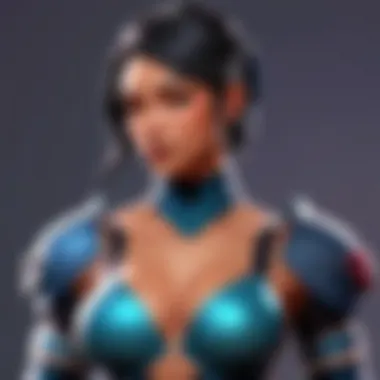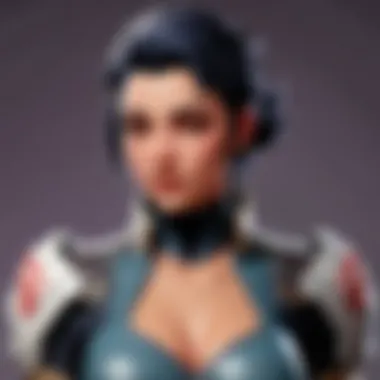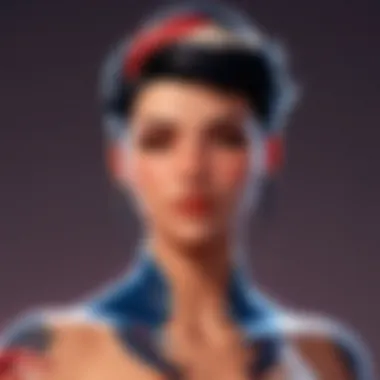Exploring the Skin Spectrum in Valorant


Game Overview
Foreword to Valorant
Valorant is a tactical first-person shooter developed by Riot Games. It combines elements from various genres to create a unique experience where strategy and teamwork are essential. Players select from a roster of agents, each with distinct abilities, which adds layers of complexity beyond standard shooting mechanics. The game emphasizes precision and communication, making it appealing for both casual gamers and competitive players alike.
Game mechanics and objectives
The core gameplay revolves around two teams competing to either attack or defend. The attacking side must plant a bomb, called the Spike, while the defending side aims to thwart their plan. Winning rounds requires good coordination, understanding of agent abilities, and map knowledge. Players accumulate credits to buy weapons and abilities during subsequent rounds, introducing an economic strategy component.
Brief history of the game
Valorant was officially released on June 2, 2020, after a successful closed beta. The game quickly gained traction, appealing to both existing players from tactical shooters and newcomers. Riot Games actively supports Valorant with regular updates, introducing new content, agents, and maps, which help sustain player interest and engagement over time.
Playable agents and their unique abilities
Valorant features a diverse set of agents. Each agent falls into specific categories, such as Duelists, Controllers, Initiators, and Sentinels. For example, Jett excels in mobility and swift attacks, while Sage focuses on healing and support. Understanding the unique abilities of each agent can significantly influence game strategies.
Significance of Skins
Valorant skins refer to cosmetic items that change the appearance of weapons and agents. They have garnered considerable interest within the community. Not merely decorative, skins encapsulate player identity and status. Many players invest time and money to obtain the latest designs.
Economic Implications
The presence of skins and their allure generates significant revenue for Riot Games. Players are often willing to spend real currency on in-game purchases. This economic model illustrates how cosmetic items can create a steady income stream while fostering a community around customization.
Cultural Relevance
Skins in Valorant reflect trends in gaming culture. They can depict various themes, artistry, and influences that resonate with players. This connection contributes to a sense of belonging within the community, as players share their unique collections and discuss preferences.
"Skins are more than just visuals; they represent a player's personality and commitment to the game."
Types of Skins
Skins can be categorized into various tiers based on their rarity and design. Here are the main categories:
- Common: Basic designs, often available for purchase at lower prices.
- Rare: More intricate designs with additional animations.
- Legendary: Exclusive skins with unique features, often tied to specific events.
- Elderflame: A premium tier known for its elaborate animations and thematic concepts.
Community Engagement
Skins have fostered a vibrant community interaction, from showcases on Reddit to social media discussions on Facebook. These platforms allow players to convey their opinions, share content, and create trends around skin collections.
End
Understanding the skin spectrum in Valorant not only enhances player enjoyment but also offers insights into broader gaming culture and economic considerations. Awareness of this intricate element helps shape player identity and engagement within the game. Players can embrace their unique style and contribute to the community by participating in the ongoing discussion around skins.
Understanding the Skin Spectrum
Understanding the skin spectrum in Valorant is essential for grasping the full impact of skins within the game. Skins are not just visual enhancements; they often carry significant cultural, economic, and aesthetic value for the player community. Their importance extends beyond mere decoration. By examining skins, players can relate to their characters and the overall gaming experience on a deeper level.
The skin spectrum reflects the variety of options available. It encompasses everything from basic designs to intricate, unique looks that often appeal to specific player tastes. This broad range offers benefits like personal expression and individuality. Players can choose skins that resonate with their personalities or that signify achievements. Additionally, specific skins often become status symbols among players. Some may even find motivation in acquiring coveted skins, driving them to engage more deeply with the game.
When players choose their skins, it impacts their view of the game. They are a part of how players perceive the game as a whole. Moreover, understanding the skin spectrum helps to identify unique trends within the community, which can lead to discussions about preferences and values shared among players.
The study of skins in Valorant also brings attention to their role in the evolving landscape of gaming. With the continuous introduction of new skins, the game remains relevant and exciting. Therefore, this topic deserves a thorough investigation to appreciate how much skins contribute to Valorant and its gameplay.
Defining Skins in Valorant


In Valorant, skins refer to cosmetic items that players can equip to their weapons and, in some cases, characters. These skins change the appearance of weapons without altering their performance or capabilities. The primary purpose of a skin is cosmetic, allowing players to express their individuality while gaming.
Skins can vary greatly in their design, from simple color changes to elaborate themes that might evoke different cultures or artistic styles. Players have access to various categories, allowing for diversity in weapon appearance. Some skins are available for purchase, while others may be earned through gameplay or special events.
The definition of skins in Valorant is grounded in the game’s commitment to aesthetic value. While all players can appreciate the gameplay mechanics, it is the skins that allow for a unique personal touch.
Historical Context of Skins in Gaming
The concept of skins in gaming is not a new one. The practice of customizing the appearance of items goes back many years. In the earlier days, games typically had limited graphical capabilities, and customization was limited. However, as games evolved, so did the idea of adding skins.
Games like Team Fortress 2 and Counter-Strike 1.6 demonstrated that players enjoyed personalizing their experiences. These games set the stage for modern skin systems, showing potential economic benefits too. Popularity increased profitability through microtransactions, paving the way for more intricate customization options.
Valorant fits into this broader trend, incorporating skins as a core component. By offering a vast array of skins, Riot Games capitalizes on both the aesthetic appeal and the economic potential seen in earlier titles. Today, skins represent not only a way for players to personalize their experience but also a significant aspect of gaming culture as a whole.
Categories of Skins
The Categories of Skins in Valorant are a vital topic to explore. They provide a framework for understanding the wide array of skins available in the game. Each category not only highlights the diversity found in player customization but also serves different player needs and aesthetic preferences. Understanding these categories helps players make informed decisions about their purchases and collections.
Common Skins
Common skins are the most basic category. They are typically characterized by their lower price points and straightforward designs. These skins are easily obtainable and are often included in the game’s default offerings. While they lack the elaborate animations or unique effects seen in higher-tier skins, they still allow players to personalize their experience without a significant investment.
- Accessibility: Common skins are among the first that players encounter. They create a sense of ownership and identity, especially for new players.
- Aesthetic Choices: Even common skins can feature appealing design elements, making them attractive for players who prefer simplicity.
- Psychological Factors: Players often feel satisfaction when using any skin, reinforcing their connection to the game.
Rare Skins
Rare skins elevate the customization experience further. These skins are usually distinguished by intricate designs, animations, and sound effects. They are harder to obtain than common skins and often require higher financial investment or specific achievements.
- Investment Value: Rare skins can act as status symbols within the community, reflecting a player's dedication and skill.
- Enhanced Experience: The extra attention to detail makes gameplay more engaging. Players may derive joy simply from using their rare skins, which can influence their overall gaming experience.
- Market Demand: Given their rarity, they often have a higher market value, making them sought after by players.
Event-Specific Skins
Event-specific skins are created to celebrate special occasions or in-game events. These skins contribute to a sense of community and shared experiences. Players often look forward to these releases as they can foster nostalgia and excitement within the player base.
- Limited Availability: Typically, event-specific skins are only available for a limited time, which can drive demand higher during the event.
- Thematic Consistency: Such skins often tie into broader narratives or themes present during the events they celebrate, enhancing immersion.
- Bonuses and Celebrations: These skins can commemorate significant milestones in the game or highlight player achievements during that timeframe.
Battle Pass Skins
Battle pass skins are unique to Valorant as they represent a progression system in which players earn rewards as they play. This system encourages continued engagement with the game.
- Incentivization: Players are motivated to participate in various challenges to unlock these skins, making gameplay more interactive and rewarding.
- Variety: Battle pass skins often boast a variety of designs that cater to different preferences, appealing to a broader audience.
- Community Connection: They can promote a sense of camaraderie among players who are engaged in the same season's challenges.
"Skins are not just a cosmetic feature; they reflect a player's journey and identity within Valorant."
In summary, the categorization of skins in Valorant is essential to understanding their broader significance. Each category, from common to battle pass skins, serves distinct purposes and appeals to different player motivations. This nuanced approach to skin categories not only enriches the aesthetic landscape of Valorant but also enhances player identity and community engagement.
Economic Aspects of Skins
The economic implications of skins within Valorant represent a critical factor in the game's ecosystem. Understanding how skins are monetized, valued, and affect the in-game economy provides insights into player behavior and the broader business model of the game. The aspect of skins reflects not only a source of revenue for the developer, Riot Games, but also represents a market where players engage actively, seeking to enhance their experience.
Monetization Strategies
Riot Games employs various monetization strategies to maximize profits from skins. These strategies often include:
- Direct Purchases: Players can buy skins through microtransactions, purchasing individual items or bundles.
- Battle Passes: Seasoned players may opt for battle passes, which provide access to exclusive skin lines and earnable cosmetic rewards over time.
- Limited-Time Offers: Exclusive skins offered during events or specific seasons create urgency among players to make purchases. This strategy not only boosts sales in a short period but also keeps players engaged.
Additionally, collaborations with popular culture entities can introduce themed skins, attracting diverse player demographics, thus further boosting monetization.
Market Value and Trading


Skins in Valorant aren't just digital items; they have a market value that fluctuates based on demand, rarity, and aesthetics. Players often seek to acquire rare skins, which can lead to increased prices on secondary markets. Factors affecting skin value include:
- Rarity: Unique or limited-edition skins typically hold higher value.
- Condition: Some skins have variations in condition that affect their aesthetics, influencing market price.
- Popularity: Skins tied to popular characters or themes can see significant price increases.
Forums and platforms dedicated to trading skins have emerged, providing spaces for players to negotiate and exchange items. However, this trading can lead to challenges, such as potential scams.
Impact on In-Game Economy
The in-game economy of Valorant is considerably influenced by the existence of skins. They contribute to player engagement and satisfaction. The emphasis on skin acquisition can lead players to invest more time and money in the game. Key aspects include:
- Player Retention: Engaging skin collections foster a sense of community and loyalty.
- Economic Balance: The introduction of skins should not disrupt in-game mechanics, ensuring that performance remains unaffected by cosmetic choices.
- Investment: As players acquire and trade skins, it creates a dynamic where players feel invested, not just financially, but in the gaming experience as a whole.
"Skins have transcended their role as mere aesthetics; they are now integral to the community and economic frameworks within Valorant."
In summary, the economic aspects of skins in Valorant create a complex environment that benefits both players and developers. Understanding these nuances can enhance the gaming experience, illustrating the deeper connection between player identity and economic activity in the gaming industry.
Cultural Relevance of Skins
The cultural relevance of skins in Valorant cannot be understated. They do not merely serve as cosmetic upgrades; rather, they echo the players' identities, preferences, and aspirations within the game environment. Skins have transformed into a form of digital attire, allowing players to express their unique styles. When a player selects a skin, it often reflects their affinity for certain designs or themes, contributing to a sense of belonging in a diverse community.
Players often see skins as an extension of themselves. For instance, while some may prefer sleek and minimalist designs, others might opt for vibrant and elaborate patterns. This variety enables a rich tapestry of self-expression, fostering an interactive loop between players and the game. Further, skins can evoke tactical benefits on certain maps or scenarios, where bright or dark skins might affect visibility and strategy. This intersection of personal style and gameplay creates a nuanced conversation within the gaming community.
Identity and Self-Expression
Valorant skins offer players opportunities for identity exploration and self-expression. In a game often characterized by competitive play, players find an avenue to assert individuality through their choice of skins. The act of equipping a skin provides a sense of ownership and personal connection to the game. For many players, this emotional investment is significant.
Players often share screenshots of their preferred characters with specific skins on social platforms like Reddit or Facebook. This sharing fosters connections with other players who appreciate similar aesthetics. Moreover, limited edition skins can create an air of exclusivity, heightening their value within the community. This aspect ties closely to the concept of social currency among gamers, where being well-versed in skins can enhance one's reputation in both casual and competitive environments.
Community Reactions and Trends
Community reactions to skins can reveal deeper trends in player psychology and culture. When new skins are released, the community's response ranges from excitement to critique. Platforms like Reddit often serve as arenas for debate, where players discuss not merely the design but the implications of pricing, accessibility, and gameplay dynamics.
Trends in skin popularity reflect broader cultural shifts. For instance, seasonal themes such as Halloween or major esports events often yield skins influenced by current events or pop culture. This phenomenon illustrates how Valorant skins are not just game elements but also mirrors of societal interests.
To conclude, while skins in Valorant serve multiple purposes, their cultural relevance is rooted in personal expression and community dynamics. They transform gameplay from a mere competition to a canvas where players can exhibit identity, making skins an enduring feature of the Valorant experience.
Skin Collection and Customization
The realm of skin collection and customization in Valorant plays a pivotal role in shaping not only the gaming experience but also player identities. Valaront's extensive catalog of skins allows players to express their individualism and creativity, which enhances their overall engagement with the game. This segment explores both the appeal of collection and the available customization options that make the skin system intricate and alluring.
The Appeal of Collection
The act of collecting skins in Valorant is more than merely acquiring digital items; it reflects a player's journey and accomplishments within the game. Many gamers find satisfaction in amassing a collection that showcases their style and achievements. Moreover, a diverse skin collection can create a sense of prestige among peers in the gaming community. Factors that drive this appeal include:
- Uniqueness: Each skin embodies a distinct design and theme. Owning a rare skin can distinguish players in match lobbies.
- Investment: Skins can be viewed as investments. With some skins increasing in value, they can offer potential financial returns.
- Nostalgia: Certain skins may evoke memories of past gameplay experiences, reinforcing their sentimental value.
Collecting skins establishes a connection to the game that transcends mere participation. It enriches a player's experience, making them feel more integrated within the Valorant universe.
Customization Options Available
Valorant offers several avenues for skin customization, enabling players to curate their gaming aesthetics. This option not only personalizes characters but also enhances the visual experience. The following customization features are noteworthy:
- Skin Variants: Many skins offer different variants, often unlocking additional designs or colors to reflect a player's mood or style.
- Weapon Finish: Players can change the finish of their weapons, from sleek metallic surfaces to vibrant animations.
- Animation Effects: Certain skins come with special animations, giving dynamic visual flair during gameplay.
Customization in Valorant extends beyond the superficial. Since skins can influence how players relate to their environment, it can enhance focus and immersion.
"Customization is key to making players feel connected to their gameplay experience."
Ultimately, the skin collection and customization facets offer players more than aesthetic choice; they provide a platform for self-expression and deepening engagement with Valorant. As players acquire and modify skins, they contribute to a culture where identity and aesthetics intertwine, shaping their distinctive in-game presence.


Skins and Gameplay
Skins in Valorant play a vital role that extends far deeper than mere cosmetic changes. They impact how players engage with the game, which in turn can influence performance and enjoyment. By understanding this relationship, players can make informed decisions about their in-game purchases and choices.
Aesthetic Influence on Performance
Many players believe that the appearance of their weapons can subtly affect their performance in matches. This could be attributed to several factors, including distraction and enhanced focus. When players use skins that resonate with their personal style, they can feel more connected to their gameplay experience. This heightened connection potentially leads to increased focus and improved decision-making during crucial moments.
Equally important is the notion of familiarity. Players who invest time in certain skins may become accustomed to the weapon’s design, which can lead to better aim and spatial awareness. A stylish or visually appealing skin may also boost a player's confidence, which can psychologically manifest in better gameplay. Ultimately, the aesthetic appeal of skins contributes to overall player motivation.
"The choice of a skin isn’t just about looks; it can influence how a player feels and plays in the game."
Psychological Effect on Players
The skins players choose often serve as extensions of their personalities. This self-expression can contribute to a positive gaming experience. The psychological aspect of skins fosters a sense of ownership and individuality. Players often take pride in their collections, engaging in social interactions centered on their favorite skins.
Moreover, there is a psychological phenomenon known as the Endowment Effect, where people place a higher value on items merely because they own them. This applies directly to skins, as players may perceive their skins as more valuable compared to others, regardless of market price.
In competitive scenarios, the selection of a skin can be strategic as well. Some skins may carry specific reputations within the community, affecting how opponents perceive a player. For instance, a highly sought-after skin might carry an implicit expectation of skill level and experience. This can create a mental advantage or disadvantage depending on the player's choice.
Future Trends in Skins
The landscape of skins in Valorant is constantly evolving. Assessing future trends is essential to understanding how they will shape player experiences and the game environment. Innovations and technology advancements play a significant role in this progression. Players are becoming more demanding, looking for a deeper connection to the items they use.
Innovations in Skin Design
As technology progresses, the design of skins is pushing new boundaries. More intricate and detailed patterns are possible thanks to refined graphics engines and better modeling techniques. Players increasingly expect unique design elements that represent personal style or in-game achievements.
Some of the notable innovations in skin design include:
- Dynamic Skins: Skins that can change based on gameplay or player actions are gaining popularity. This adds another layer of engagement, allowing players to witness a visual progression that aligns with their performance.
- Interactive Features: Developers are exploring the incorporation of animations or sound effects that activate under specific circumstances. A skin that reacts based on in-game events creates an immersive experience.
- Collaborative Designs: Partnerships with artists or other games can lead to exclusive skin designs. This not only broadens the aesthetic appeal but also taps into different fanbases, enhancing the game's overall imagery.
These trends indicate a future where skins are not merely decorative elements but integral parts of gameplay and community culture.
The Role of AI in Personalization
Artificial intelligence is also changing how skins are created and personalized for players. AI technology enables developers to analyze player preferences more accurately, leading to tailored experiences. Here are several ways AI is influencing skin personalization:
- Data-Driven Design: AI can analyze player behavior to identify popular trends. Utilizing this data helps in the creation of skins that resonate well with the community.
- Automated Customization: AI can suggest skin modifications or completions based on a player’s previous choices. Imagine a situation where players receive personalized skin options without extensive manual searching.
- Community Feedback Integration: AI tools can track community discussions and reactions in real-time, refining skin offerings based on majority preferences.
Such advancements not only enhance the player experience but also align skin aesthetics with community expectations and game trends.
The future of skin personalization rests on adapting to player demands, ensuring that each item feels unique and relevant to its owner.
End
End
In this article, the exploration of skins in Valorant allows for a deeper understanding of their significance. This section serves as a synthesis of the crucial elements discussed throughout. Skins are not merely cosmetic assets; they have transformed the gaming culture, impacting identity and expression among players. Economic implications also play a vital role, shaping how players engage with the game.
Summary of Key Insights
The journey through the skin spectrum has unveiled several vital insights:
- Diversity of Skins: From common to event-specific, each category offers unique aesthetic experiences.
- Economic Impact: Skins have become a substantial part of Valorant's economy, affecting monetization strategies and market trading. Their market value often fluctuates based on player demand and rarity.
- Cultural Significance: The role of skins extends beyond mere appearance; they serve as a medium for personal expression and community identity, often creating trends.
"Skins transcend their visual appeal, embedding themselves into the broader culture of gaming and player interaction."
The psychological effects of skins also create a deeper engagement, influencing player confidence and performance. Each skin carries a story, connecting players to their in-game experiences.
The Enduring Appeal of Skins
The attraction of skins in Valorant endures due to a few key reasons:
- Personalization: Players have an innate desire to stand out and foster uniqueness. Skins provide an easy way for individuals to showcase their style.
- Community Influence: As players interact with one another, trends emerge around certain skins. This cycle of popularity promotes engagement and investment in new designs.
- Collectability: Many players enjoy collecting skins, not just for use in-game, but as a hobby. This collection mindset creates excitement around new releases and limited-edition skins.



